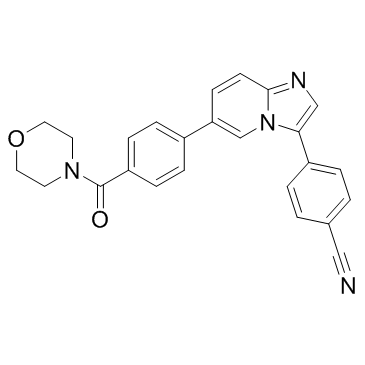| Cas No.: | 1464151-33-4 |
| Chemical Name: | 4-(6-(4-(morpholine-4-carbonyl)phenyl)imidazo[1,2-a]pyridin-3-yl)benzonitrile |
| Synonyms: | ETC206;ETC 206;ETC-1907206 |
| SMILES: | N#CC1C=CC(C2N3C(C=CC(=C3)C3C=CC(C(=O)N4CCOCC4)=CC=3)=NC=2)=CC=1 |
| Formula: | C25H20N4O2 |
| M.Wt: | 408.452 |
| Purity: | >98% |
| Sotrage: | 2 years -20°C Powder, 2 weeks 4°C in DMSO, 6 months -80°C in DMSO |
| Publication: | [1]. Yang H, et al. Optimization of Selective Mitogen-Activated Protein Kinase Interacting Kinases 1 and 2 Inhibitors for the Treatment of Blast Crisis Leukemia. J Med Chem. 2018 May 24;61(10):4348-4369. |
| Description: | ETC-206 is a selective MNK1 and MNK2 inhibitor with IC50s of 64 nM and 86 nM, respectively. |
| Target: | MNK1:64 nM (IC50) MNK2:86 nM (IC50) |
| In Vivo: | The antitumor effect of ETC-206 is then assessed in a K562 e/o eIF4E mouse xenograft model after oral administration at 25, 50, or 100 mg/kg alone or in combination with a 2.5 mg/kg fixed dose of Dasatinib throughout the study. Dasatinib at 2.5 mg/kg elicits a tumor growth inhibition (TGI) of 88% with one tumor-free animal. In contrast, ETC-206 alone only yields a maximum TGI of 23% at the highest administered dose of 100 mg/kg, which does not impede tumor growth, and is similar to the nontreated animals. ETC-206 with 2.5 mg/kg of Dasatinib not only increases tumor growth inhibition in a dose-dependent manner but, more importantly leads to 2, 5, and 8 out of 8 tumor-free animals at 25, 50, and 100 mg/kg, respectively. The combination of ETC-206 and Dasatinib inhibits tumor growth at all tested doses, and no weight loss is recorded. Both the combination of ETC-206 and Dasatinib and, on the other hand, the dual MNK1/2 and BCR-ABL1 inhibitors prevent tumor growth in the same mouse xenograft model. ETC-206 has moderate terminal elimination half-life (t1/2=1.7 h, and 1.77 h for mouse (1 mg/kg, i.v.), mouse (5 mg/kg, p.o.))[1]. |
| In Vitro: | ETC-206 inhibits eIF4E phosphorylation in HeLa cell line with an IC50 of 321 nM. The anti-proliferative effects of ETC-206 are assessed in vitro, using CellTiter-Glo viability assay against 25 hematological cancer cell lines including the K562 cell line that overexpresses eIF4E (K562 o/e eIF4E). The IC50s are 1.71 μM, 3.36 μM, 3.70 μM, 4.81 μM, 5.13 μM, 5.05 μM, 6.70 μM, 9.76 μM, and 48.8 μM for SU-DHL-6, GK-5, MC 116, P3HR-1, DOHH2, MPC-11, Ramos.2G6.4C10, AHH-1, and K562 o/e eIF4E cells, respectively[1]. |
| Cell Assay: | The anti-proliferative effects of ETC-206 are assessed in vitro, using CellTiter-Glo viability assay against 25 hematological cancer cell lines including the K562 cell line that overexpresses eIF4E (K562 o/e eIF4E). The IC50s are in general in the micromolar range[1]. |
| Animal Administration: | Mice[1] CD-1 female mice (6-8 weeks old) are weighed, and those selected for dosing are 24±2 g. Three mice are randomly grouped per time point. Mice are administered a single dose of 1 mg/kg of ETC-206 via tail vein injection or a single dose of 5 mg/kg of ETC-206 via oral gavage. The volume of injection for intravenous (i.v.) and oral (p.o.) administration is 4 mL/kg and 8 mL/kg, respectively[1]. |
| References: | [1]. Yang H, et al. Optimization of Selective Mitogen-Activated Protein Kinase Interacting Kinases 1 and 2 Inhibitors for the Treatment of Blast Crisis Leukemia. J Med Chem. 2018 May 24;61(10):4348-4369. |

 DC Chemicals' products qualify for U.S. tariff exemptions. We guarantee no price increases due to customs duties and maintain stable supply, continuing to deliver reliable research solutions to our American clients.
DC Chemicals' products qualify for U.S. tariff exemptions. We guarantee no price increases due to customs duties and maintain stable supply, continuing to deliver reliable research solutions to our American clients.





















